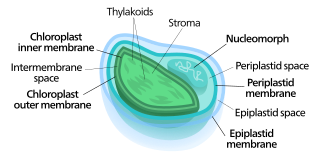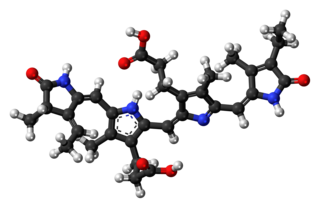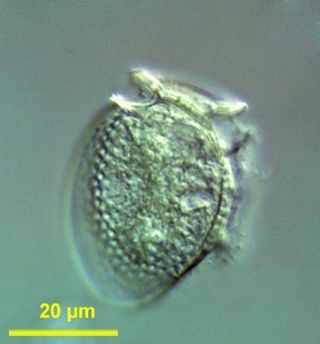Related Research Articles

The cryptomonads are a group of algae, most of which have plastids. They are common in freshwater, and also occur in marine and brackish habitats. Each cell is around 10–50 μm in size and flattened in shape, with an anterior groove or pocket. At the edge of the pocket there are typically two slightly unequal flagella.

Chromista is a proposed but polyphyletic biological kingdom consisting of single-celled and multicellular eukaryotic species that share similar features in their photosynthetic organelles (plastids). It includes all eukaryotes whose plastids contain chlorophyll c and are surrounded by four membranes. If the ancestor already possessed chloroplasts derived by endosymbiosis from red algae, all non-photosynthetic Chromista have secondarily lost the ability to photosynthesise. Its members might have arisen independently as separate evolutionary groups from the last eukaryotic common ancestor.

Nucleomorphs are small, vestigial eukaryotic nuclei found between the inner and outer pairs of membranes in certain plastids. They are thought to be vestiges of primitive red and green algal nuclei that were engulfed by a larger eukaryote. Because the nucleomorph lies between two sets of membranes, nucleomorphs support the endosymbiotic theory and are evidence that the plastids containing them are complex plastids. Having two sets of membranes indicate that the plastid, a prokaryote, was engulfed by a eukaryote, an alga, which was then engulfed by another eukaryote, the host cell, making the plastid an example of secondary endosymbiosis.
Phycobilins are light-capturing bilins found in cyanobacteria and in the chloroplasts of red algae, glaucophytes and some cryptomonads. Most of their molecules consist of a chromophore which makes them coloured. They are unique among the photosynthetic pigments in that they are bonded to certain water-soluble proteins, known as phycobiliproteins. Phycobiliproteins then pass the light energy to chlorophylls for photosynthesis.

The cryptophyceae are a class of algae, most of which have plastids. About 220 species are known, and they are common in freshwater, and also occur in marine and brackish habitats. Each cell is around 10–50 μm in size and flattened in shape, with an anterior groove or pocket. At the edge of the pocket there are typically two slightly unequal flagella.

Phycocyanobilin is a blue phycobilin, i.e., a tetrapyrrole chromophore found in cyanobacteria and in the chloroplasts of red algae, glaucophytes, and some cryptomonads. Phycocyanobilin is present only in the phycobiliproteins allophycocyanin and phycocyanin, of which it is the terminal acceptor of energy. It is covalently linked to these phycobiliproteins by a thioether bond.

The cryptomonads-haptophytes assemblage is a proposed but disputed monophyletic grouping of unicellular eukaryotes that are not included in the SAR supergroup. Several alternative names have been used for the group, including Hacrobia ; CCTH ; and "Eukaryomonadae".

Rhodomonas is a genus of cryptomonads. It is characterized by its red colour, the square-shaped plates of its inner periplast, its short furrow ending in a gullet, and a distinctly shaped chloroplast closely associated with its nucleomorph. Historically, Rhodomonas was characterized by its red chloroplast alone, but this no longer occurs as its taxonomy has become increasingly based on molecular and cellular data. Currently, there is some debate about the taxonomic validity of Rhodomonas as a genus and further research is needed to verify its taxonomic status. Rhodomonas is typically found in marine environments, although freshwater reports exist. It is commonly used as a live feed for various aquaculture species.
Geminigera /ˌdʒɛmɪnɪˈdʒɛɹə/ is a genus of cryptophyte from the family Geminigeraceae. Named for its unique pyrenoids, Geminigera is a genus with a single mixotrophic species. It was discovered in 1968 and is known for living in very cold temperatures such as under the Antarctic ice. While originally considered to be part of the genus Cryptomonas, the genus Geminigera was officially described in 1991 by D. R. A. Hill.

Guillardia is a genus of marine biflagellate cryptomonad algae with a plastid obtained through secondary endosymbiosis of a red alga.

Hemiselmis is a genus of cryptomonads.

Dinophysis is a genus of dinoflagellates common in tropical, temperate, coastal and oceanic waters. It was first described in 1839 by Christian Gottfried Ehrenberg.
Mesodinium chamaeleon is a ciliate of the genus Mesodinium. It is known for being able to consume and maintain algae endosymbiotically for days before digesting the algae. It has the ability to eat red and green algae, and afterwards using the chlorophyll granules from the algae to generate energy, turning itself from being a heterotroph into an autotroph. The species was discovered in January 2012 outside the coast of Nivå, Denmark by professor Øjvind Moestrup.
Goniomonadea is a proposed class of cryptomonads which includes the orders Goniomonadida and Hemiarmida.
Hemiarma marina is a monotypic species of cryptomonad discovered off the coast of Palau in 2016.
Tetragonidiaceae is a family of cryptomonads which includes two genera. Members of Tetragonidiaceae are distinguished from other cryptomonads by reproduction occurring in a non-motile vegetative phase, as well as the formation of multicellular filaments unlike any other cryptomonad family.

Pyrenomonadaceae is a family of cryptomonads which includes three or four known genera. They are distinguished from other cryptomonads by their nucleomorphs being imbedded into the pyrenoid, and the presence of distinctive pigment phycoerythrin 545.
Chroomonadaceae is a family of cryptomonads first recognized by Clay et al in 1999 as including genera Chroomonas, Falcomonas, and Komma. Following a molecular phylogenic study in 2002, Hemiselmis was also placed within the Chroomonadaceae. Today, the family is generally recognized as sister to the Pyrenomonadaceae.
Hilleaceae was one of the three families of Cryptomonads proposed by R.W. Butcher in 1967, who included only the genus Hillea. It has appeared in at least two other cryptomonad classification systems since then. However, as Hillea has yet to be successfully cultured, its validity as a genus remains uncertain.
Pleuromastigaceae is an obsolete family of cryptomonads, which included genera Monomastix, Pleuromastix, and Xanthodiscus.
References
- ↑ Hill, David R. A. (1991). "Chroomonas and Other Blue-Green Cryptomonads". Journal of Phycology. 27 (1): 141. doi:10.1111/j.0022-3646.1991.00133.x. S2CID 84657275.
- ↑ Brec L. Clay & Paul Kugrens (1999). "Characterization of Hemiselmis amylosa sp. nov. and phylogenetic placement of the blue-green cryptomonads H. amylosa and Falcomonas daucoides". Protist . 150 (3): 297–310. doi:10.1016/S1434-4610(99)70031-3. PMID 10575702.